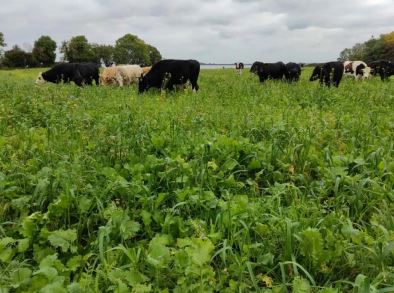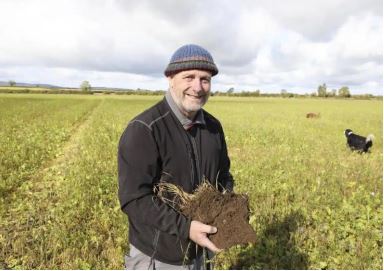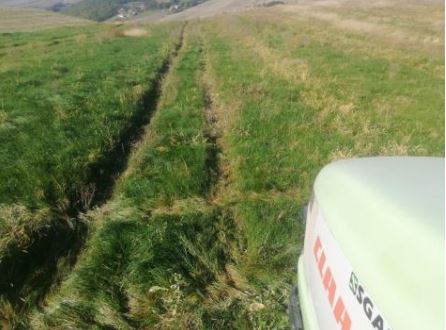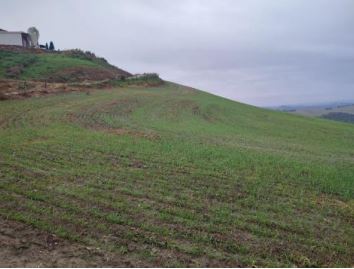Categories
no-tillage
Mervyn Auchmuty
Success Story
Farming as a Way of Life
Growing up on the family farm, farming for Mervyn Auchmuty has always been his way of life; “I never became a farmer, I was always one”. Now, Mervyn and his father Robert are farming together on their picturesque 400-acre arable (tillage) and mixed livestock farm in County Roscommon.
Minimum Tillage (Min Till)
Mervyn was first introduced to the idea of ‘Regenerative Agriculture’ in 2013, through learning the concept of “minimum tillage” or “min till” (minimum disruption of the soil). The Auchmuty’s land is stoney and therefore difficult to plough, taking many man hours to do so. Removing ploughing from their workload meant less hours ploughing, picking stones, burning diesel, and preparing cropland. The advantages of ‘min till’ were clear for their land. For many, the idea of not ploughing or tilling arable land seems ludicrous, but Mervyn managed to convince his father Robert that it could be a good idea.
Strip-Tilling
And so, the father-and-son duo removed the process of ploughing their soil, and they invested in a “Strip-Till Drill” through the aid of a TAMS (Targeted Agriculture Modernisation Schemes) grant. This Strip-Till allowed the pair to greatly reduce the amount of soil being tilled, only tilling the strips of land where crops were being sown. Mervyn explained the importance of minimum disturbance to the soil for keeping the soil microbes alive, which enhances the nutrient quality of the soil over time. Now the pair also use a “Direct Drill”, which does exactly what it says on the tin; directly drilling the crops into the soil without tilling at all.
Cover Crops
Another benefit to ‘Min Till’ is that most of the soil can remain covered with plants. Mervyn explained how the soil can degrade when there are no plants to cover it; due to factors such as the reduced ability for the soil to absorb carbon and the exposure of the soil to the elements (Sun, Wind, Rain). Therefore, cover crops play a crucial role in the period after crops have been harvested, to cover the bare soil with temporary plants to promote photosynthesis, carbon sequestration and good soil health. The use of cover crops is a practice which many tillage farmers do not observe, yet this changing, increased understanding of the benefits of cover crops through research, and the introduction of government incentives for cover crops are slowly increasing the use of this practice in Ireland.
Improved Root Structure
Mervyn has noticed how the root structure of his crops have improved since he began trialling Regenerative Agriculture practices back in 2013. Plant roots play a vital part in aerating the soil; allowing for better water absorption and providing vital nutrients to the soil.
Natural Fertilisers
The Auchmutys create natural compost with farmyard manure. This process for many farms is now a forgotten practice, as slurry is a more popular modern technique, even though it emits much higher amounts of greenhouse gases (methane, carbon dioxide) and toxic fumes (ammonia and hydrogen sulphide). The creation of natural compost calls for extra time and man hours from the farmers, but the natural benefits are clearly worth it for Mervyn and Robert.
Mervyn has experimented with seaweed and seed washes for naturally fertilising his cropland and seeds. Through his experimentation, he has found that treating seeds before planting leads to longer and stronger root systems and healthier soils.
Part of the Irish Regenerative Agriculture Community
In 2018, Mervyn joined the farmer-run regenerative agriculture group called “BASE Ireland”. Here, farmers share their experiences, ideas, and lessons of advice to other farmers trying out these alternative farming methods. The BASE (Biodiversity Agriculture Soil Environment) group allows farmers to educate each other, chat online, and host knowledge-sharing workshops.
As well as this, Mervyn has engaged in several NOTS (National Organic Training Skillnet) training courses and soil testing initiatives. He has learned a lot from videos on YouTube and through reading internet resources, and he does his part by sharing his knowledge and experience to other farmers through the BASE group.
Engaging in Regenerative Agriculture has kept Mervyn and his father Robert motivated on their farm. Each year, the duo trial new regenerative practices, which helps “keeps it interesting”. Mervyn hopes to continue to learn and trial at least one new regenerative agriculture practice each year.
LABELS: Ireland, Crop Production, Livestock, Green Fertilisation, Biodiversity, Biodynamic Agriculture, Crop Rotation, Min Till
Paul Moore Tillage (Arable) Farmer
Success Story
Paul Moore is a Tillage farmer near Midleton, Co. Cork. He farms 56 hectares, growing crops such as Malting Barley, Beans and Oilseed Rape, with a small herd of cattle. In 2017, Paul began experimenting with ‘Regenerative Agriculture’ practices to see if it would work for his type of farming, and for his land.
About one quarter of Paul Moore’s land is farmed regeneratively, and as he begins to learn the techniques and see improvements, he hopes to transition more of his farmland to Regenerative Agriculture. Regenerative Agriculture Practices that Paul uses include:
- Strip Tilling: Whereby only narrow strips of land are tilled (where the seeds get sewn), with the areas in-between left undisturbed. This method improves water drainage and enhances soil health, which can lead to higher crop yields.
- Wildlife Margins: Area surrounding fields that are left uncut for wildlife to flourish unharmed. Native flowers are excellent for the health of our native pollinators and natural biodiversity.
- Beetle Banks: These are wide strips of uncut land amongst tillage fields that create habitats for beetles that feed on the pests that attack crops. Natural pesticides, if you will!
Since starting Regenerative Agriculture practices, Paul has noticed an increased number of “helpful” insects on his land. These insects include Ladybirds and certain Beetles, which are natural predators to the Aphid. Aphids are pests on tillage farms that are usually killed with chemical pesticides. The Aphid population on Paul’s farm is kept low due to the predatory insects. Paul explains that his main issue with using no pesticides is having to deal with slugs! He is currently experimenting with different ways of combating slugs naturally.
Government schemes such as the old “GLAS” scheme (now evolved to the “ACRES” scheme) have allowed Paul to gain some financial support for the use of cover crops, a regenerative practice. Cover crops ensure that bare soil, which releases carbon into the atmosphere, is covered between harvest and resowing. By covering the soil with plants, photosynthesis absorbs carbon and creates nitrogen to feed the soil and reduce emissions. This process not only increases the health of the soil, but also the quality of the future crops. The longer Regenerative Agriculture is used, the more resilient the ecosystem becomes.
For Paul, the benefits of this style of farming have reduced his workload and input costs. The transition period to Regenerative Agriculture can produce lower yields for a couple years as it takes time to get the soil conditions right for sowing. However, Paul thinks that this should not deter farmers from giving Regenerative Agriculture a try, due to the multitude of benefits (such as high quality soil and crops, improved water drainage, less input costs and reduced labour) that arise from long-term practice. Paul says that Regenerative Agriculture is a slow, yet empowering process. Farmers are empowered to make their own informed decisions, based on their knowledge of their land and the local environment.
LABELS: Ireland, Crop-production, Biodiversity, Minimum Tillage.
Andrew Bergin, Arable Farmer
Success Story
Andrew Bergin farms a 90-hectare regenerative tillage farm in County Kildare, growing a wide variety of crops from peas, beans, oil seed rape, winter wheat, spring wheat, barley and oats.
Spaces for Nature
Andrew has a variety of hedgerows and natural field margins across his farm to aid biodiversity and pollinator life. Andrew sees pollinators as an indicator of the health of the environment; “if you’ve pollinators, there are a lot of other things going right”.
No Ploughing and Minimum Tillage
In 2013, Andrew saw a demonstration for a new Strip Till machine, and he could immediately see the advantages; “the crops and ground seemed happier”.
Andrew moved away from ploughing that year with the transition phased over 4 years and all arable ground ‘no-till’ by 2017 . In 2022, a 20-year old direct drill was replaced with a new one with the help of a TAMS (Targeted Agriculture Modernisation Schemes) grant . A direct drill machine does exactly what it says on the tin; directly drilling the seeds into the soil, whilst minimally disrupting the soil’s structure.
Protecting the Soil through Cover Crops
Andrew ensures that cover crops, containing a mixture of plant species, are established as quickly as possible after harvest. Maintaining a living root in the soil at all times across the land protects the soil from damage and is a key principle of Regenerative Agriculture.
Cover crops greatly reduce the amount of carbon lost to the atmosphere, as well as making the soil more resilient to extreme weather conditions.
Protecting Ground Nesting Birds
Cover crops come with more benefits than soil health, due to the high rates of nesting birds and other wildlife that are attracted to the diverse landscape. Andrew stated that “the number of ground nesting birds has exploded” since he stopped ploughing, such as Skylarks and Meadow Pippets.
Taking Part in Farmer-Led Regenerative Initiatives
Andrew is part of a project called “Danú Farming Group”, that involves 12 farms who are doing a rigorous study of the process of transitioning from conventional to regenerative farming practices over a 5-year period. Andrew enjoys learning from other farmers and taking pragmatic steps to regenerate his land.
Andrew is also a member of the Irish farmer-run regenerative agriculture group called “BASE Ireland” (Biodiversity, Agriculture, Soil & Environment). Here, farmers share their experience with regenerative agriculture and also share advice to other farmers trying out these alternative farming methods.
Andrew believes that regenerative farming “would be very hard without the BASE community and the internet”. Indeed he doesn’t think he could have ever transitioned to regenerative agriculture without the knowledge on the internet and other farmers.
Andrew’s Advice to Farmers considering Regenerative Agriculture
Andrew encourages farmers who are interested in regenerative agriculture to start slowly, taking one field at a time, for example. For tillage farmers, he suggests hiring a contractor with a no-till drill to trial the minimum till practices on their land. If it works for them, then a gradual conversion to regenerative farming is the way to go.
Regenerative Agriculture: Empowering Farmers
Andrew describes how regenerative farming is “not prescriptive” or conventional in any way. It is about using your own judgement to assess what is happening with the crop, and to apply the practices that make sense to your specific landscape. For Andrew, regenerative agriculture and no-till farming has saved him an “enormous” amount of time and money.
Being Open to New Ways of Working & Different Opinions
Andrew states that engaging in regenerative agriculture involves “keeping a very open mind” and engaging with other people and farmers to discuss new ideas and opinions. Andrew expressed the importance of sharing information “in a non-confrontational way”. He discusses the importance of farm nature walks in allowing farmers to “take the day off to chat” with like-minded farmers who can share stories and ideas with one another.
Challenges to Regenerative Agriculture in Ireland
Andrew discussed how one of the biggest obstacles to regenerative agriculture is first a lack of information, and secondly, having to take the risk of converting to a new way of farming. He hopes that further research in this area will aid in reducing the risks for farmers in their trial-and-error conversion process to regenerative agriculture.
Andrew believes that regenerative techniques can benefit conventional farming in many ways, and he hopes that the Irish advisory bodies begin to recognize this as more research gets published.
Keeping Farming Fresh & Engaging
Since beginning his journey into regenerative agriculture, Andrew states that for him, “farming is a lot more engaging and interesting now”. Andrew has met a wide variety of “interesting people and younger farmers”, expressing how this social element to regenerative agriculture has a huge community and personal development benefit.
He finds it exciting to convince other farmers of the benefits of regenerative agriculture. Andrew recognizes that this less-destructive form of agriculture can look a “bit scruffy looking” at times, but beauty is very much so in the eye of the beholder.
Andrew intends to continue farming regeneratively and is “all the time striving to find better ways” of doing things.
LABELS: Ireland, crop-production, green fertilisation, biodiversity, crop rotation, No-Tillage
Zannella’s Farm
Success Story
The Franco Zannella’s Farm is located in Candela, a small village in the province of Foggia (Apulia region, Italy). The farm has a surface area of 104 ha with 2 people as permanent staff. They are cultivating the following crops: durum wheat (Triticum durum L.), field bean (Vicia faba subsp. Minor), chickpea (Cicer arietinum L.), white clover (Trifolium repens L.), sunflower (Helianthus annuus L.). They apply soil conservation practices overall on the farm surface. Specifically, they have a sod seeding machine, therefore no-tillage management of the soil is carried out. Furthermore, they use some legumes for cover crop purposes, and they usually execute two-year rotations, alternating cereals, and legumes. The previous practices have been used from 2008 to the present (2022). They started to apply no-tillage because the soils of the farm became very poor with a low level of fertility as a consequence of deep soil works. The owner of the farm used to work as a tractor conductor for the plowing operations. He did not receive any training about the practice of soil conservation, but he learned the RA farming practices from agricultural websites and newspapers. Additionally, he did not receive any financial support to start soil conservation practices.
After the application of the RA practices, he experienced even higher grain yield compared to the previous years, better soil quality in terms of fertility as assessed by the number of earthworms in the first soil layers, a lower workload compared to the previous year, and a higher income; on the other hand, he pointed out the diffusion of weeds, especially Lolium, overall the field. For this reason, he decided to cultivate spring crops, such as sunflowers, but he highlighted the difficulty of growing sunflowers under no-tillage management. However, the farmer is very pleased to apply soil conservation practices as well as he wants to continue to apply them also because of the increasing costs of fuel.
LABELS: Italy, crop-production, no-tillage
Lanini’s farm
Success Story
The Giuseppe Lanini’s Farm is located in Mucigliano, a small municipality of Asciano in the province of Siena (Tuscany region, Italy). The farm has a surface area of 200 ha with 1 person as permanent staff and 2 people as temporary staff. In addition, the farmer works as a contractor and can cultivate 600 ha. They are cultivating the following crops: durum wheat (Triticum durum L.), barley (Hordeum vulgare L.), and different kind of clovers, mainly squarrosum and alexandrinum. Besides, the farm also includes livestock with almost 700 sheep. They apply soil conservation practices overall on the farm surface. Specifically, they carry out no-tillage management of the soil. They usually execute a four-year rotation, settling clover as the first-year crop followed by three-year cereals. In addition, they manage legumes with cover crop purposes. Anyway, a part of the sewage produced by sheep is used as fertilizer, while the other is sold.
The previous practices have been used from 2014 to the present (2022). They started to apply no-tillage because they had a very high cost for cultivation and low revenues from the sale of agricultural products. He received training on the practice of soil conservation from the company that sold him the sod seeding machine. However, he did not receive any financial support to start soil conservation practices. After the application of the soil conservation practices, he experienced a similar grain yield compared to the previous years, but with a lower workload and lower costs, in terms of fuel. Additionally, better soil quality was obtained in terms of fertility as assessed by the amount of organic matter and the number of earthworms in the first soil layers. Because of the lower workload, he was able to cultivate more land as compared to the previous years. On the other hand, he pointed out the diffusion of weeds, especially Lolium, overall the field; he solved the problem using Lolium as hay and applying the pre-emergence herbicide. Altogether, the farmer is very happy to apply soil conservation practices and he doesn’t want to change anything.
LABELS: Italy, crop-production, livestock, no-tillage






